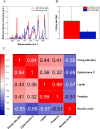Electrode- and Label-Free Assessment of Electrophysiological Firing Rates through Cytochrome C Monitoring via Raman Spectroscopy
- PMID: 39907650
- PMCID: PMC11877498
- DOI: 10.1021/acssensors.4c03133
Electrode- and Label-Free Assessment of Electrophysiological Firing Rates through Cytochrome C Monitoring via Raman Spectroscopy
Abstract
In vitro neurotoxicology aims to assess and predict the side effects of exogenous chemicals toward the human brain. Among the exploited approaches, electrophysiological techniques stand out for the high spatiotemporal resolution and sensitivity, with the patch clamp considered the gold standard technique for such purposes. However, structural toxicity and metabolic effects may elude detection when only the electrical activity is measured, highlighting the need for integrating electrophysiological recordings with complementary approaches such as optical methods. In this study, we describe an integrated platform for recording neuronal electrical activity and performing chemical analysis with a noninvasive label-free optical imaging, Raman spectroscopy. Specifically, we developed a protocol that maximizes the signal-to-noise ratio while avoiding the crosstalk of the electrical and spectroscopical readouts and any phototoxicity associated with the laser exposure. Synchronous and sequential electrical-optical measurements were carried out and compared, with the sequential approach being more suitable for the longitudinal investigation and correlation of the neuronal electrical activity to the intracellular content of reduced cytochrome C, lipids, proteins, and nucleic acids. Data analysis shows a strong correlation between the metabolic status of the single cells and the overall neuronal firing rate, suggesting the electrode- and label-free assessment of the neuronal firing rates through the monitoring of cytochrome C via Raman spectroscopy when multielectrode array devices with high electrical noise and impedance are used. Conversely, the neuronal firing rate and the reduced cytochrome C content were not correlated to lipids, proteins, and nucleic acids. Thus, this study demonstrates the crosstalk of the neuronal firing rate and reduced cytochrome C as downstream and upstream features of the neuronal metabolic activity and that through the monitoring of the de novo synthesis of lipids, proteins, and nucleic acids, Raman spectroscopy provides additional information for a more accurate assessment of the acute and chronic neurotoxicity.
Keywords: Raman spectroscopy; cytochrome C; electrophysiology; firing rate; multielectrode array; neurotoxicity.
Conflict of interest statement
The authors declare no competing financial interest.
Figures




Similar articles
-
In Vivo Observations of Rapid Scattered Light Changes Associated with Neurophysiological Activity.In: Frostig RD, editor. In Vivo Optical Imaging of Brain Function. 2nd edition. Boca Raton (FL): CRC Press/Taylor & Francis; 2009. Chapter 5. In: Frostig RD, editor. In Vivo Optical Imaging of Brain Function. 2nd edition. Boca Raton (FL): CRC Press/Taylor & Francis; 2009. Chapter 5. PMID: 26844322 Free Books & Documents. Review.
-
Label-Free Raman Spectroscopy for Assessing Purity and Maturation of hiPSC-Derived Cardiac Tissue.Anal Chem. 2024 Oct 1;96(39):15765-15772. doi: 10.1021/acs.analchem.4c03871. Epub 2024 Sep 18. Anal Chem. 2024. PMID: 39291743 Free PMC article.
-
Single-molecule detection of yeast cytochrome c by Surface-Enhanced Raman Spectroscopy.Biophys Chem. 2005 Jan 1;113(1):41-51. doi: 10.1016/j.bpc.2004.07.006. Biophys Chem. 2005. PMID: 15617809
-
Optical Electrophysiology: Toward the Goal of Label-Free Voltage Imaging.J Am Chem Soc. 2021 Jul 21;143(28):10482-10499. doi: 10.1021/jacs.1c02960. Epub 2021 Jun 30. J Am Chem Soc. 2021. PMID: 34191488 Free PMC article.
-
Active High-Density Electrode Arrays: Technology and Applications in Neuronal Cell Cultures.Adv Neurobiol. 2019;22:253-273. doi: 10.1007/978-3-030-11135-9_11. Adv Neurobiol. 2019. PMID: 31073940 Review.
References
-
- Muffat J.; Li Y.; Yuan B.; Mitalipova M.; Omer A.; Corcoran S.; Bakiasi G.; Tsai L.; Aubourg P.; Ransohoff R.; Jaenisch R. Efficient derivation of microglia-like cells from human pluripotent stem cells. Nat. Med. 2016, 22, 1358–1367. 10.1038/nm.4189. - DOI - PMC - PubMed
- Abreu C. M.; Gama L.; Krasemann S.; Chesnut M.; Odwin-Dacosta S.; Hogberg H. T.; Hartung T.; Pamies D. Microglia Increase Inflammatory Responses in iPSC-Derived Human BrainSpheres. Front. Microbiol. 2018, 9, 2766.10.3389/fmicb.2018.02766. - DOI - PMC - PubMed
- Brüll M.; Spreng A.; Gutbier S.; Loser D.; Krebs A.; Reich M.; Kraushaar U.; Britschgi M.; Patsch C.; Leist M. Incorporation of stem cell-derived astrocytes into neuronal organoids to allow neuro-glial interactions in toxicological studies. ALTEX 2020, 37 (3), 409–428. 10.14573/altex.1911111. - DOI - PubMed
- Chhibber T.; Bagchi S.; Lahooti B.; Verma A.; Al-Ahmad A.; Paul M. K.; Pendyala G.; Jayant R. D. CNS organoids: an innovative tool for neurological disease modeling and drug neurotoxicity screening. Drug Discovery Today 2020, 25 (2), 456–465. 10.1016/j.drudis.2019.11.010. - DOI - PMC - PubMed
- Fritsche E.; Haarmann-Stemmann T.; Kapr J.; Galanjuk S.; Hartmann J.; Mertens P. R.; Kämpfer A. A. M.; Schins R. P. F.; Tigges J.; Koch K. Stem Cells for Next Level Toxicity Testing in the 21st Century. Small 2021, 17 (15), 200625210.1002/smll.202006252. - DOI - PubMed
- Nzou G.; Wicks R. T.; Wicks E. E.; Seale S. A.; Sane C. H.; Chen A.; Murphy S. V.; Jackson J. D.; Atala A. J. Human Cortex Spheroid with a Functional Blood Brain Barrier for High-Throughput Neurotoxicity Screening and Disease Modeling. Sci Rep . 2018, 8, 7413.10.1038/s41598-018-25603-5. - DOI - PMC - PubMed
-
- Schmidt B. Z.; Lehmann M.; Gutbier S.; Nembo E.; Noel S.; Smirnova L.; Forsby A.; Hescheler J.; Avci H. X.; Hartung T.; Leist M.; Kobolák J.; Dinnyés A. In vitro acute and developmental neurotoxicity screening: an overview of cellular platforms and high-throughput technical possibilities. Arch. Toxicol. 2017, 91, 1–33. 10.1007/s00204-016-1805-9. - DOI - PubMed
-
- Gao J.; Zhang H.; Xiong P.; Yan X.; Liao C.; Jiang G. Application of electrophysiological technique in toxicological study: From manual to automated patch-clamp recording. TrAC 2020, 133, 11608210.1016/j.trac.2020.116082. - DOI
Publication types
MeSH terms
Substances
LinkOut - more resources
Full Text Sources

